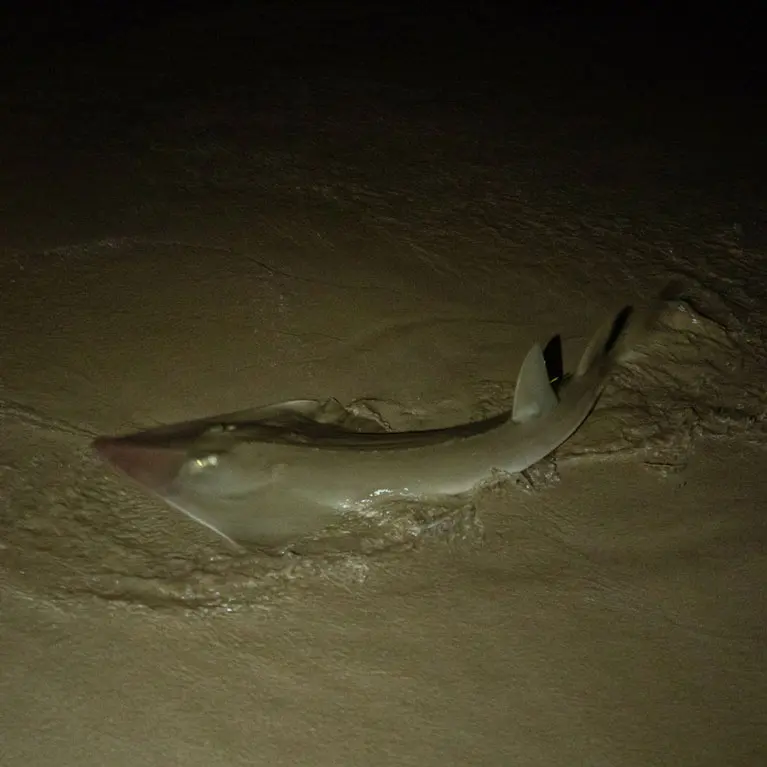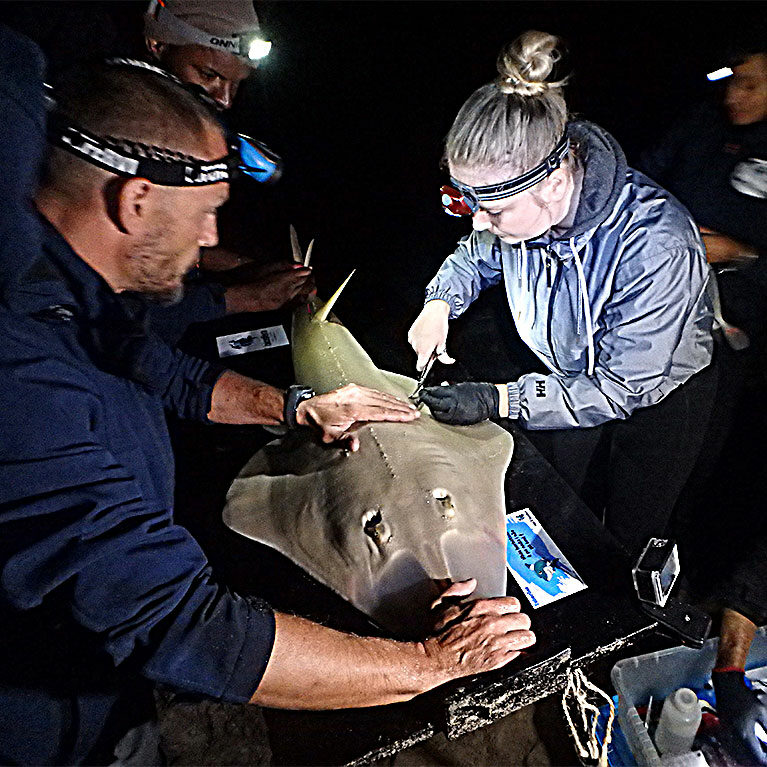It’s in the Genes: conserving Cabo Verde’s blackchin guitarfish populations
Although most of Kirsti’s work is lab-based in Germany, she’s building a reference genome (all the genetic material for the species) for Cabo Verde’s blackchin guitarfish. Critically Endangered blackchin guitarfish are regularly sighted around the uninhabited island of Santa Luzia, which is one of 10 islands peppered around Cabo Verde, an archipelago 600 km off Senegal in West Africa. Kirsti, researchers and local fishers catch these guitarfish and take small tissue samples before releasing them. This population will provide a new resource to be used for future research and conservation efforts of blackchin guitarfish – and other species of giant guitarfish.
As far back as I can remember, I have had a profound curiosity about the ocean and a particular fascination for sharks and rays. Some of the first drawings I brought home from school to my parents were of sharks surrounded by smaller fish and blue water, and unlike most children who spoke about becoming teachers or veterinarians, I always wanted to become a marine biologist. I was fortunate to grow up on the east coast of Canada and near the ocean, which allowed me to develop this love for and curiosity about the underwater world. Life was best spent...


It’s in the genes: conserving Cabo Verde’s blackchin guitarfish populations
The primary objective of my project will be to use recent advances in DNA sequencing technology to assemble a reference genome for the blackchin guitarfish in particular and for the giant guitarfish group more generally. This new resource will be immensely important for research into giant guitarfish and for their conservation.
Giant guitarfish and wedgefish are among the most endangered groups of marine fish globally, but the current available genetic data for these species are limited. Filling this knowledge gap by assembling a high-quality reference genome for blackchin guitarfish in particular and giant guitarfish more generally will provide the tools needed to use genomics to study the population of these species. Ultimately, these analyses will help inform appropriate and critical conservation efforts.
Giant guitarfish and wedgefish have become two of the most endangered marine fish families in the world. Very little is known about these unique animals, but they face a high risk of extinction due to targeted fisheries and by-catch. With my project I will make use of recent advances in DNA sequencing technology to fill the gap in knowledge about their genetics by assembling a high-quality reference genome for the blackchin guitarfish in particular and for the group more generally. Using this new resource, I will estimate the effective size of the Santa Luzia population in Cape Verde (that is, I will estimate the number of productive individuals in the population by analysing their genome) and establish whether it is genetically distinct from populations of blackchin guitarfish off mainland Africa. The blackchin guitarfish can be found along the eastern Atlantic coast from northern Portugal to Angola, including the Mediterranean, and has recently been discovered around the island of Santa Luzia in Cape Verde. This species grows slowly, matures late and has relatively few young, which is the perfect recipe to make a species highly vulnerable to exploitation. In addition, the blackchin guitarfish is expected to be particularly vulnerable to trawling because it lives in shallow, sandy and muddy coastal areas. Having a shallow-water lifestyle may also result in demographic and genetic isolation between the Cape Verde and mainland Africa populations due to the great water depths between the island nation and mainland Africa. Nevertheless, virtually nothing is known about the blackchin guitarfish from Santa Luzia. Additionally, Cape Verde is a region of paramount importance for chondrichthyans in the North Atlantic and tropical eastern Atlantic and may represent a refuge for the Critically Endangered blackchin guitarfish and other shark and ray species.
Utilising recent advances in DNA sequencing technology for my primary objective, I will assemble a reference genome for the blackchin guitarfish in particular and for the giant guitarfish group more generally. Future objectives then include using this reference genome to estimate the effective population size of the blackchin guitarfish from Santa Luzia. These analyses will complement ongoing efforts to collect baseline demographic data (age, growth rate and sex) on this recently discovered population to inform its management and conservation. Lastly, a future objective would be to use this reference genome to determine whether the Santa Luzia population is genetically distinct from mainland populations. If this is the case, it would be even more important to protect this population in Cape Verde. Baseline demographic and genetic data are needed to turn Santa Luzia into a refuge for the blackchin guitarfish and other shark and ray species. Work on the project will also help to build a bridge between local stakeholders (for outreach and the collection of baseline demographic data) and an institute and research group of international standing (for genome assembly).

